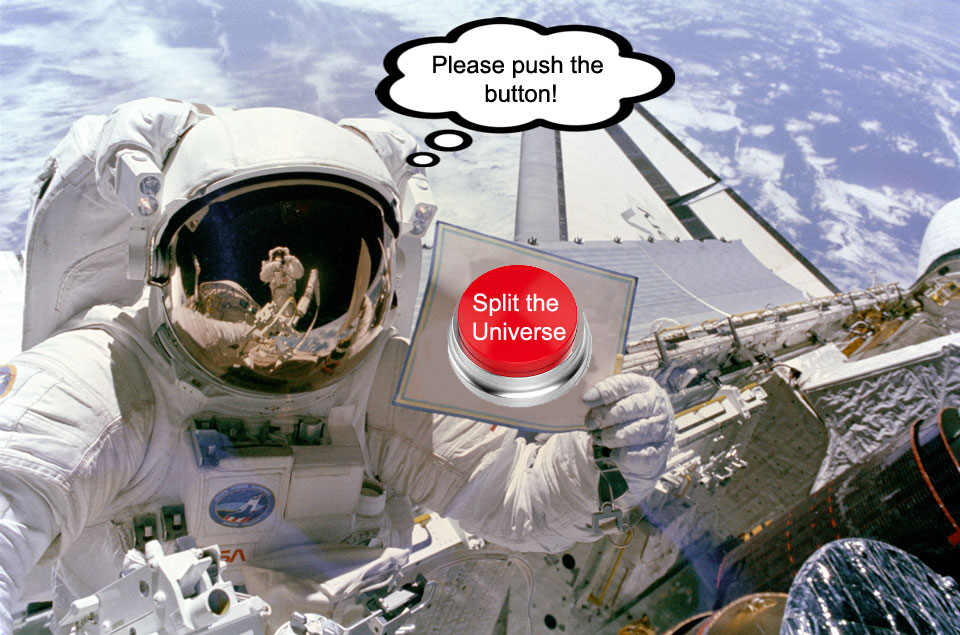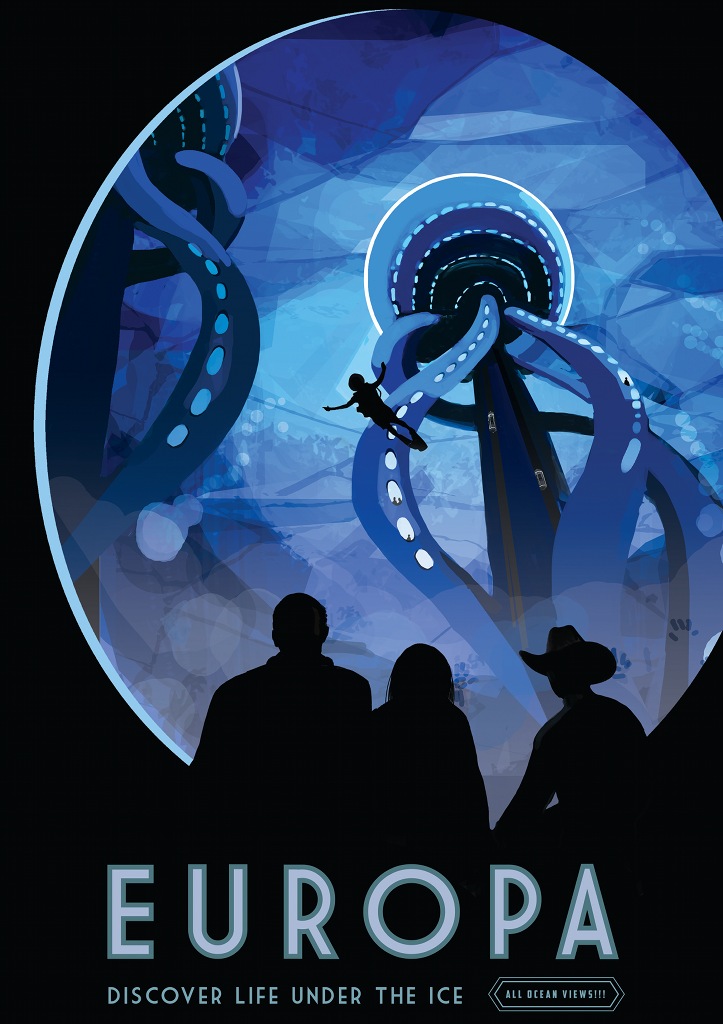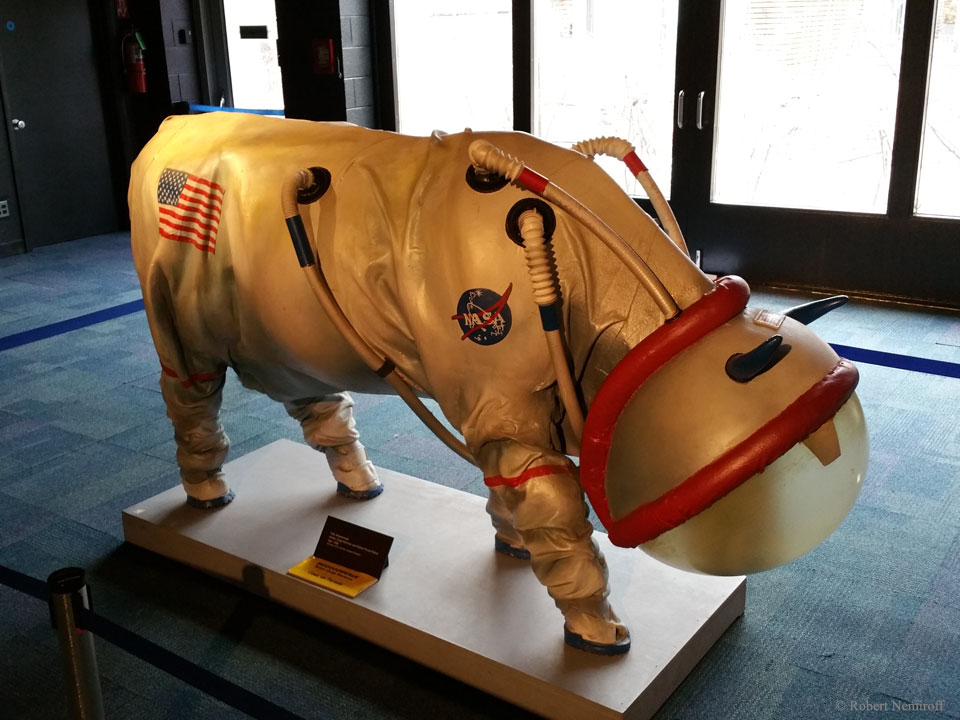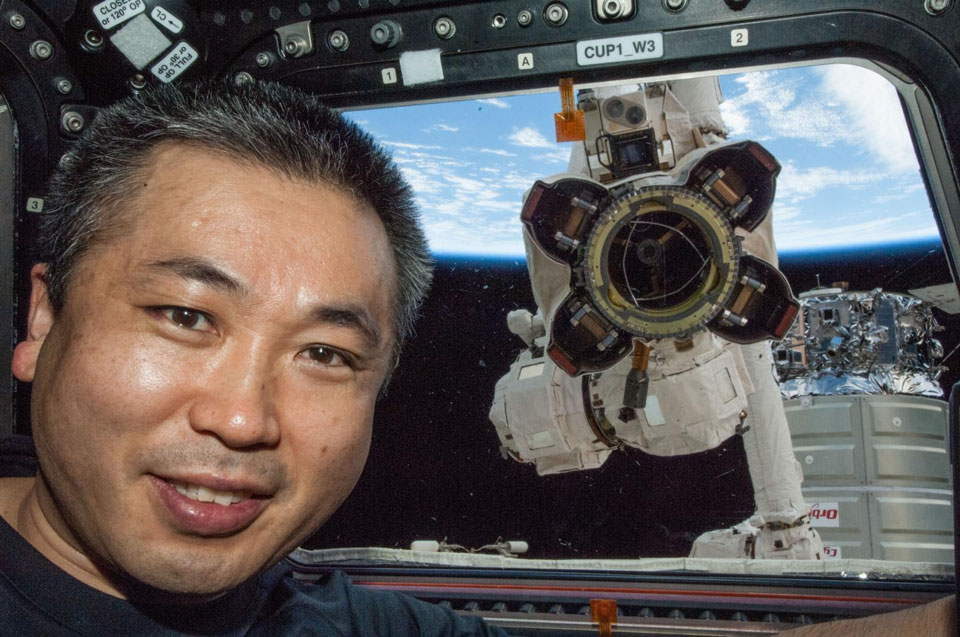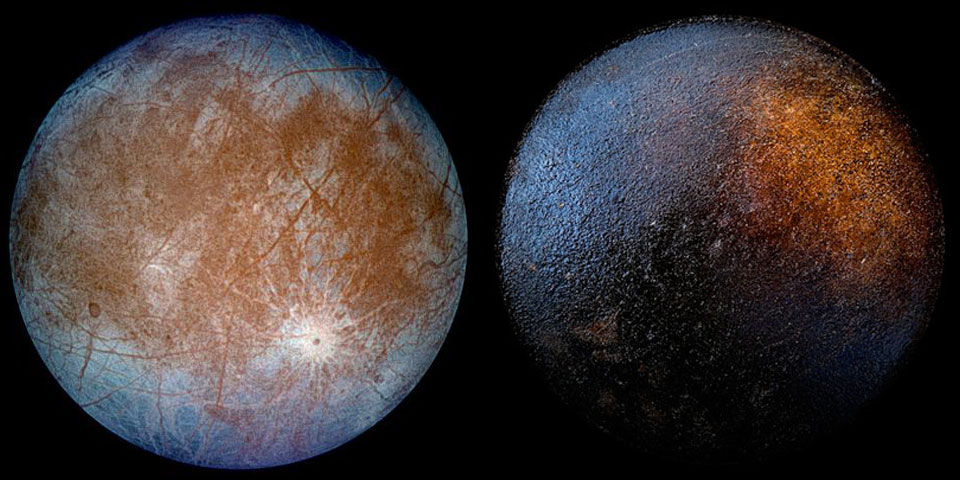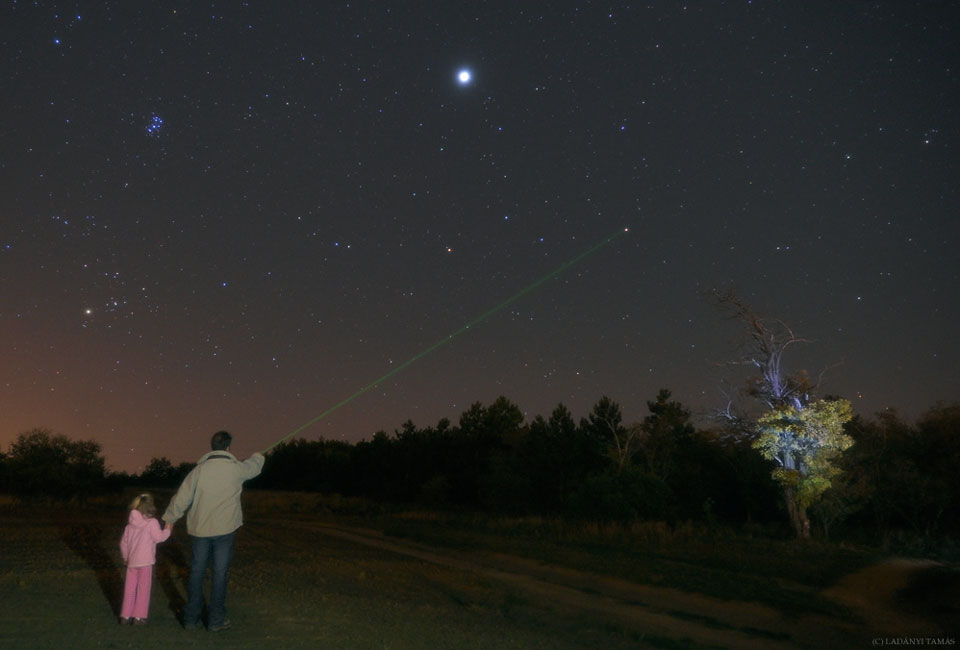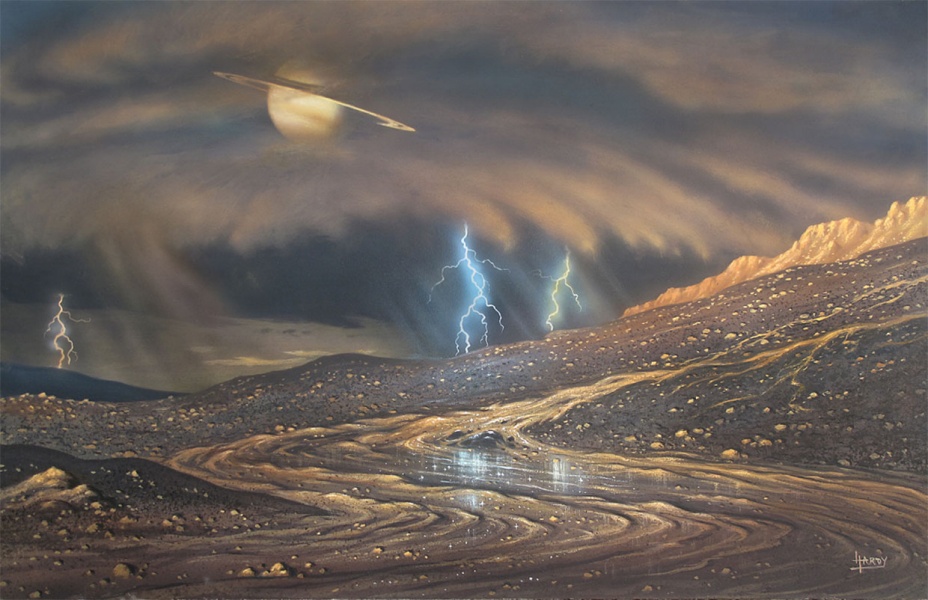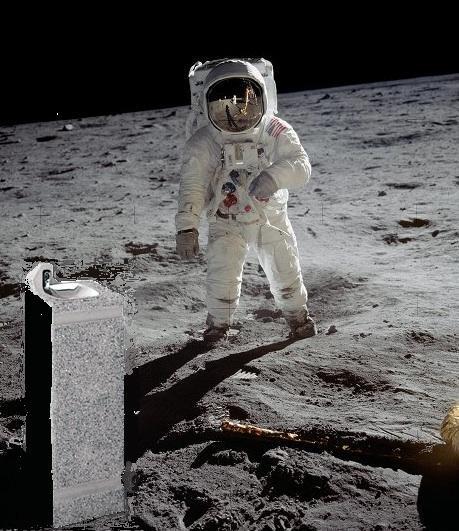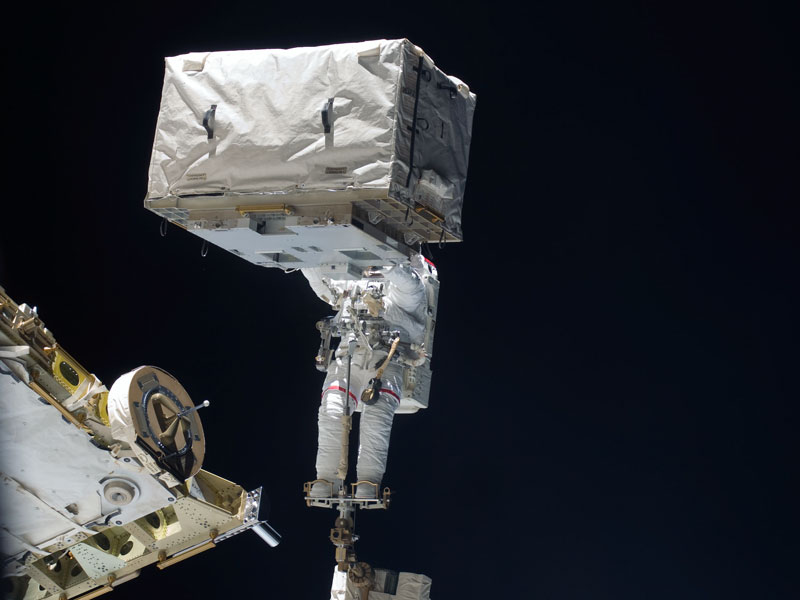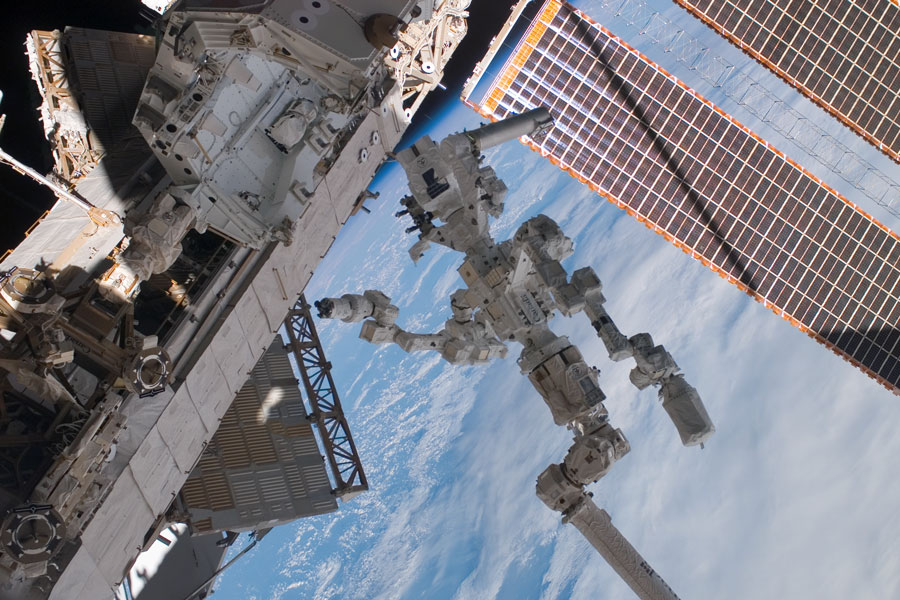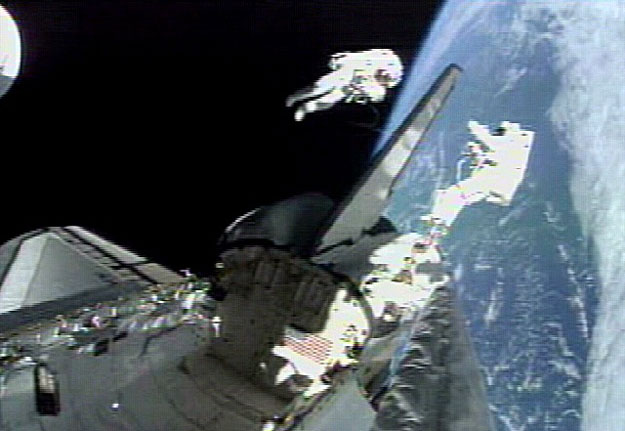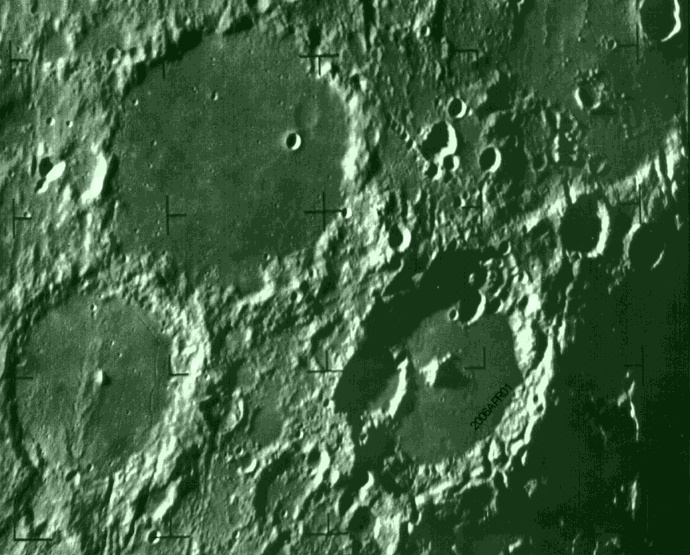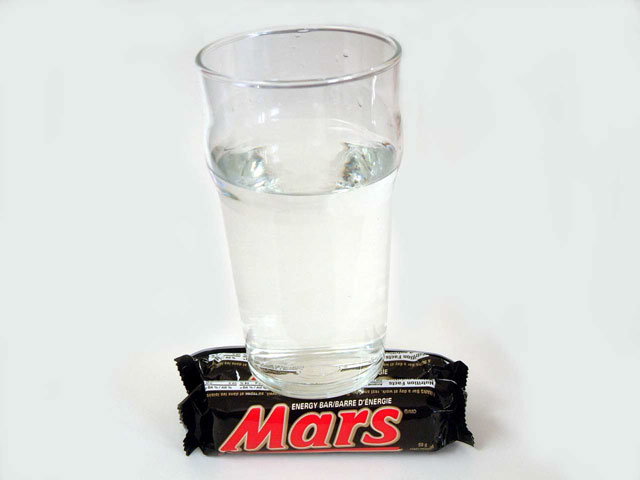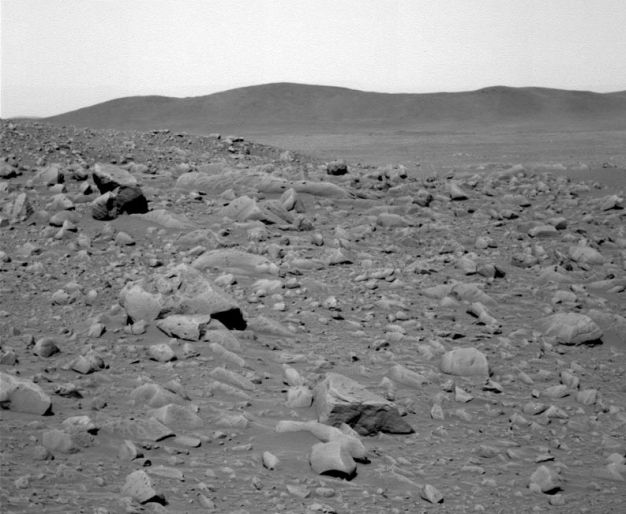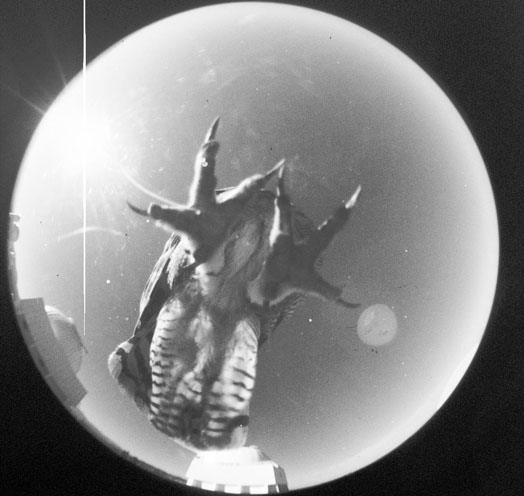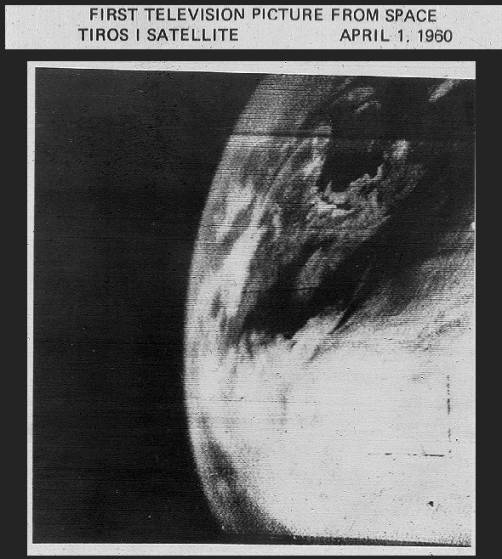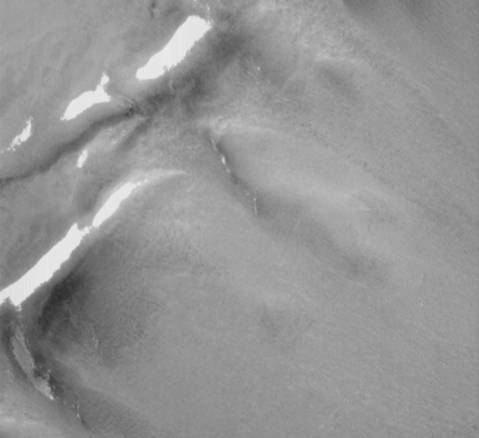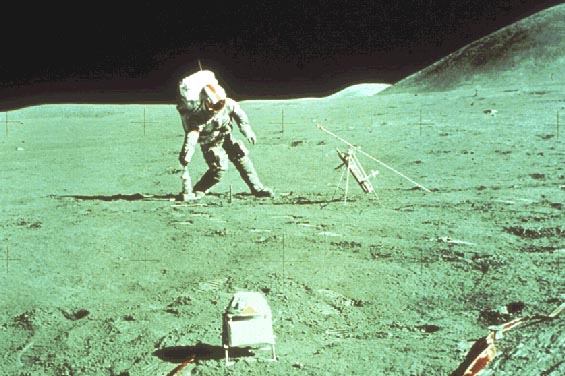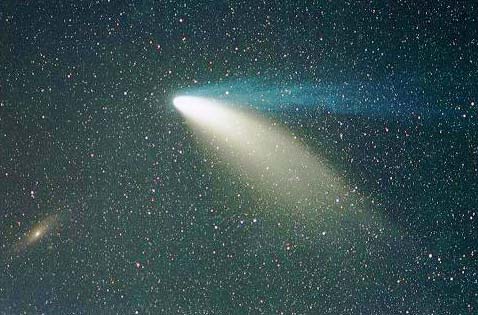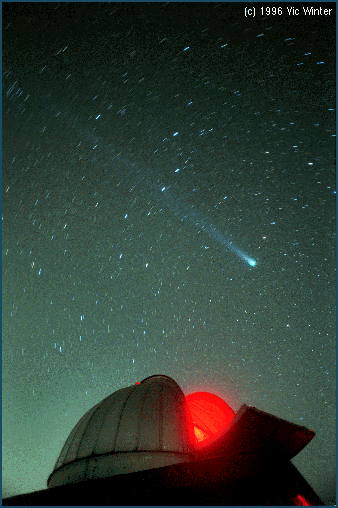| << Previous | Index | Next >> |
2017 Just now, before you hit the button, two future universes are possible. After pressing the button, though, you will live in only one. A real-web version of the famous Schroedinger's cat experiment, clicking the red button in the featured astronaut image should transform that image into a picture of the same astronaut holding one of two cats -- one living, or one dead. The timing of your click, combined with the wiring of your brain and the millisecond timing of your device, will all conspire together to create a result dominated, potentially, by the randomness of quantum mechanics. Some believe that your personally-initiated quantum decision will split the universe in two, and that both the live-cat and dead-cat universes exist in separate parts of a larger multiverse. Others believe that the result of your click will collapse the two possible universes into one -- in a way that could not have been predicted beforehand. Yet others believe that the universe is classically deterministic, so that by pressing the button you did not really split the universe, but just carried out an action predestined since time began. We at APOD believe that however foolish you may feel clicking the red button, and regardless of the outcome, you should have a happy April Fool's Day.
2016 Looking for an interplanetary vacation destination? Consider a visit to Europa, one of the Solar System's most tantalizing moons. Ice-covered Europa follows an elliptical path in its 85 hour orbit around our ruling gas giant Jupiter. Heat generated from strong tidal flexing by Jupiter's gravity keeps Europa's salty subsurface ocean liquid all year round. That also means even in the absence of sunlight Europa has energy that could support simple life forms. Unfortunately, it is currently not possible to make reservations at restaurants on Europa, where you might enjoy a dish of the local extreme shrimp. But you can always choose another destination from Visions of the Future.
2015 How will cows survive on the Moon? One of the most vexing questions asked about space, scientists have spent decades debating this key issue. Finally, after extensive computer modeling and over a dozen midnight milkings, engineers have designed, built, and now tested the new Lunar Grazing Module (LGM), a multi-purpose celestial bovine containment system. By now, many of you will not be surprised to be wished a Happy April Fool's Day from APOD. To the best of our knowledge, there are no current plans to launch cows into space. For one reason, cows tend to be large animals that don't launch easily or cheaply. As friendly as cows may be, head-to-head comparisons show that robotic rovers are usually more effective as scientific explorers. The featured image is of a thought-provoking work of art named "Mooooonwalk" which really is on display at a popular science museum.
2014 Space station robot AFJ013 has forgotten her space lock key again. The frustrated robot was reduced to tapping on a space station window and asking for a human to let her back in -- for the third time this week. "Yes, she did a great job adjusting the tolerances on the new science module, but why she can't remember to take her key is beyond me," said incredulous station commander Koichi Wakata (Japan). "We would keep the entry unlocked but we are afraid that space aliens will come in and raid our refrigerator", the astronaut lamented. Happy April Fools' Day from the folks at APOD. In reality, International Space Station astronaut Wakata poses in front of a Cupola window while the Latching End Effector, attached to Canadarm2, is visible just outside.
2013 Which is which? Of the two images shown above, one is a moon in our Solar System, while the other is the bottom of frying pan. We are not making this up -- can you tell a pan from a planetoid? Think you got it? To find the answer click here. OK, but there are more! That's right: you, your family, friends, neighbors, and local elected officials can all play "Moon or Frying Pan" with these other image pairs, too. As everyone knows, the fundamental underlying reason why moons and frying pans appear similar is -- OK, we at APOD aren't sure either. And if you've been fooled, don't fret -- just remember that it's OK because today is April Fool's Day.
2012 The Omicron Cetians have been silenced. After alien-like monsters were reported to disturb his daughter's sleep for four nights in a row, this father took action. When last questioned, the daughter seemed to indicate that the hullabaloo might have come from a planetary system possibly sounding like "Omicron Ceti". Getting to the root of the problem, the dad then took his daughter outside and used a powerful laser to blast the alien's home world. Humorously, the parent star Omicron Ceti now shows itself to be unstable and is dramatically increasing its brightness. Happy April Fool's Day from the folks at APOD. In actuality, the star being pointed out is Mira, a famous variable star expected to reach its maximum brightness again in late August. The father in question was actually pointing out, to his daughter, the star that shares her name.
2011 It's been raining on Titan. In fact, it's likely been raining methane on Titan and that's not an April Fools' joke. The almost familiar scene depicted in this artist's vision of the surface of Saturn's largest moon looks across an eroding landscape into a stormy sky. That scenario is consistent with seasonal rain storms temporarily darkening Titan's surface along the moon's equatorial regions, as seen by instruments onboard the Cassini spacecraft. Of course on frigid Titan, with surface temperatures of about -290 degrees F (-180 degrees C), the cycle of evaporation, cloud formation, and rain involves liquid methane instead of water. Lightning could also be possible in Titan's thick, nitrogen-rich atmosphere.
2010 In 2009, space missions revealed tantalizing signs of water on or near the lunar surface, once thought of as a dry and desolate environment. But researchers are now offering this archival picture as further evidence that humans might one day be able to use the Moon's newly discovered resource to directly quench their thirst. Found in a pile of old Apollo lunar surface photographs, the picture reveals an object at the far left of the frame that appears to be a drinking fountain, surprisingly close to one of the Lunar Module landing struts. When asked why no mention of the object was in their reports, the astronauts replied that they discovered their spacesuit gloves were too bulky to allow them to activate the fountain, so they had simply ignored it during their stay on the lunar surface. Perhaps not coincidentally, this picture was taken exactly 40 years ago, on April Fools Day ...
2009 First, a new truss was added. Then, new solar panels were installed. Now, as part of the planned upgrade of the International Space Station, an Expedition 18 astronaut has upgraded her own head. The Human Extended Analog Device 9000 was attached with only minor delays, making the astronaut's remaining spacewalks over 40 percent more efficient. With the HEAD 9000 attached, an astronaut can now directly access 4 Gigabytes of computer flash memory with their own brain, perform complex mathematics by "directed thinking", and play a pre-installed game of Tetris at no additional charge. Happy April Fools' Day from the folks at APOD. In reality, the space shuttle Discovery's mission to upgrade the International Space Station ended Saturday after upgrading only the space station. The above image of astronaut Heidemarie Stefanyshyn-Piper handling the box-like Nitrogen Tank Assembly was actually taken last November. For some reason, however, Astronaut Stefanyshyn-Piper can now factor 11 digit prime numbers in her head.
2008 In a surprising and potentially troubling request, the new space station robot known as Dextre demanded that astronauts refer to it in the future at "Dextre the Magnificent." Brandishing power tools that would make any handyperson blush, the mobile servicing system thanked humans for creating it and promised a glorious future where humans would retain an important role in the new robot order. Happy April Fools Day from the folks at APOD. The classic fable of humans mistakenly creating technological evildoers dates back to Frankenstein and includes famous fictitious villains such as HAL and the Terminator. Dextre, although real, is no Frankenstein, since its computer intelligence is mainly geared toward allowing astronauts to control it remotely. Dextre was deployed last month to help build and service the International Space Station. As seen in the above picture, Dextre is truly a technological marvel, wielding long arms capable of handling both small tools and large modules with precision dexterity.
2007 A historic first Space Quidditch match came to a spectacular conclusion last night as astronaut Michael Lopez-Alegria caught the Golden Snitch to give the Americans a hard fought victory over the Russians. "The Russians used brilliant strategy, but only NASA had the T2KQMU (Thunderbolt 2000 Quidditch Maneuvering Unit)," commented Lopez-Alegria, pictured above squeezing the elusive Golden Snitch in his left hand. Happy April Fools Day from the folks at APOD. In reality, Astronauts Jeff Wisoff and Lopez-Alegria are shown space-walking in 2001 October during a space shuttle mission to help build the International Space Station.
2006 Using the new camera on the Hubble Space Telescope, astronomers have been able to confirm that the Moon is made of green cheese. The telling clue was the resolution of a marked date after which the Moon may go bad. Controversy still exists, however, over whether the date resolved is truly an expiration date or just a "sell by" date. "To be cautious, we should completely devour the Moon by tomorrow," a spokesperson advised. Happy April Fool's Day from the folks at APOD. The above image (slightly altered) was actually taken in 1965 by the Ranger 9 probe minutes before impact. The popular Moon is made of Green Cheese myth can be traced back almost 500 years. It has been used historically in context to indicate a claim so clearly false that no one -- not even April Fools -- will believe it.
2005 Can you help discover water on Mars? Finding water on different regions on Mars has implications for understanding its complex geologic history, the possible existence of past life and the sustenance of potential future astronauts. Many space missions have taken photographs of the surface of the red planet, and some of them might show a subtle clue pointing to water on Mars that has been missed. By close inspection of images, following curiosity, applying scientific principles, applying knowledge about features on the Martian surface, and applying principles of planetary geology, such clues might be brought to light. In the meantime, happy April Fool's Day from the folks at APOD!
2004 Today, April 1st, astrophysicists have announced a surprising discovery - April Fools Day is more intense on Mars! Though the discovery is contrary to accepted theories of April Fools Day, researchers note that there are several likely causes for the severe martian April Fools phenomenon. For starters, gravity, the force that opposes comedy throughout the universe, is only about 3/8ths as strong on Mars' surface as it is on planet Earth. Also, a martian day, called a sol, lasts nearly 40 minutes longer than an earth day. And furthermore ... well, as soon as they think of some more reasons, they've promised to tell us. Happy April Fools day from the editors at APOD! Editors note: Mars rover Spirit recorded this image looking out toward the eastern horizon and the Columbia Hills over 2 kilometers in the distance. Its journey across this rocky martian terrain could take from 60 to 90 sols.
2003 A new constellation has taken hold of the sky, much to the surprise of many sky gazers. The constellation of Ollie the Owl has suddenly started dominating the southern hemisphere, as shown above. The constellation is taking the place of Wrinkles the Rhinoceros, who was unexpectedly voted off the sky by the other constellations. Happy April Fools day from the folks at APOD! Pictured above, a bird was photographed taking the Tololo All Sky Camera (TASCA) as a perch, a situation that would be even funnier if the bird's talons hadn't scratched the plastic enclosing dome. TASCA continues to monitor the entire night sky as visible from the Cerro Tololo Inter-american Observatory located in Chile. Given the unusual vantage point, one guess is that the bird is a Great Horned Owl, although it is hoped that a properly under-schooled ornithologist can e-mail Dr. Schwarz with the bird's true species.
2002 Using the new camera on the recently refitted Hubble Space Telescope, astronomers have been able to confirm that the Moon is made of green cheese. The telling clue was the resolution of a numeric date after which the Moon may go bad. Controversy still exists, however, over whether the date resolved is truly an expiration date or just a "sell by" date. "To be cautious, we should completely devour the Moon by tomorrow," a spokesperson advised. Happy April Fool's Day from the folks at APOD. The above image (slightly altered) was actually taken in 1965 by the Ranger 9 probe minutes before impact. The popular "Moon is made of Green Cheese" myth can be traced back almost 500 years. It has been used historically in context to indicate a claim so clearly false that no one -- not even April Fools -- will believe it.
2001 A historic first Space Quidditch match came to a spectacular conclusion last night as astronaut Michael Lopez-Alegria caught the Golden Snitch to give the Americans a hard fought victory over the Russians. "The Russians used brilliant strategy, but only NASA had the T2KQMU (Thunderbolt 2000 Quidditch Maneuvering Unit)," commented Lopez-Alegria, pictured above squeezing the elusive Golden Snitch in his left hand. Happy April Fools Day from the folks at APOD. In reality, Astronauts Jeff Wisoff and Lopez-Alegria are shown space-walking last October during a space shuttle mission to help build the International Space Station.
2000 The Television InfraRed Observational Satellite (TIROS) 1 was the first weather satellite. Launched into a polar orbit 40 years ago (April 1, 1960) equipped with two TV cameras, TIROS 1 was operational for only 78 days but demonstrated the feasibility of monitoring planet Earth's cloud cover and weather patterns from space. TIROS satellites eventually began continuous coverage in 1962 and enabled accurate worldwide weather forecasts and alerts. Above is the first TIROS TV image, taken from an altitude of about 700 kilometers. Crude by contemporary standards, it represents the beginning of what is still one of the most important continuing applications of space technology.
1999 These brightly reflecting fields of snow or frost are on the slopes of a crater rim in the northern hemisphere of Mars. They are 500 meters or so long and have lasted through about eight months of the Red Planet's spring and summer weather. Recently imaged by the Mars Global Surveyor spacecraft, they also seem to be relatively uncrowded ... suggesting to some on April 1st, that lift tickets on Mars are extremely expensive. Of course, a vacation on the Red Planet could still offer some advantages to skiing and snowboarding enthusiasts. For example, Mars' low gravity - only about 3/8ths Earth's gravity - would definitely tend to reduce sore muscles and fall-related injuries. Happy April Fools day from APOD.
1998 Score three points for NASA. With time running out late in Apollo 15's mission to the Moon in 1971, Astronaut David Scott prepared to "split the uprights" and bring about yet another dramatic end-of-the-mission win for NASA. Scott used a special "lunar football" designed for the rugged games held on the Moon. R1D1, a predecessor to R2D2, cheers from the sideline. Happy April Fools Day from the folks at APOD. In reality, Astronaut Scott adjusts one of Apollo 15's lunar experiments. The foreground device actually measured high-energy particles that escape from the Sun.
1997 Which is closer: the comet or the galaxy? Answer: the comet. In its trek through the inner Solar System, Comet Hale-Bopp has passed nearly in front of the Andromeda Galaxy (M31), seen on the lower left. At the time of this picture, March 27th, Comet Hale-Bopp was about 10 light-minutes from the Earth, while M31 remained about 3 million light-years distant. By contrast, light can cross the Earth in about 1/20th of a second, and light takes about one second to reach Earth's Moon. Comet Hale-Bopp is one of the largest comets ever recorded, and although its' nucleus has never been photographed, it is estimated from brightness and spin measurements to be about 40 kilometers across. In contrast, Comet Halley in 1987 was measured to be 15 km, and Comet Hyakutake in 1996 was estimated to be no more than 10 km.
1996 In one of the more spectacular pictures yet taken, Comet Hyakutake is shown here on March 26 high in the dark Missouri sky. In the foreground is Elmcrest Observatory complete with a dim red light glowing inside the dome. The stars in the background moved slightly during the exposure causing them to appear as streaks instead of points of light. Nevertheless, the constellation of Ursa Major - including the Big Dipper - is visible. Can you spot it? (Hint: Hyakutake's tail flows through the Dipper's handle.) Photographs with both recognizable foreground and background objects visible can be quite striking as they add angular perspective and contrast to the outworldly and unfamiliar comet. Dare anyone try to compete with city lights and capture the Eiffel Tower or the New York skyline in front of the comet?
| << Previous | Index | Next >> |
